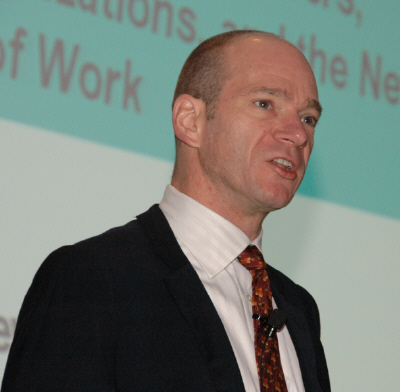Office 2.0, Enterprise 2.0, and other numerological mysteries

Andrew McAfee, an associate professor at the Harvard Business School, is studying the effects of wikis, blogs, tag and predictive markets (which he calls Enterprise 2.0) on enterprises. He outlined some of his findings and definition Office 2.0 in a presentation at the Office 2.0 conference this morning."This is just the early days, the state of knowledge is very low," McAfee said. "Assumptions are dangerous at this stage."
He also said that the default today is the status quo, not building a platform that demonstrates any emergence or self-organization via technologies like blogs and wikis. "If we build it, they will come is a dead wrong philosophy," he added. "Managers say they don't have good way to tap into the human capital of the company. With SAP you get inventory balances, but you can't tap into what project, who knows what, who is held up by peer is the expert on the subject. There aren't tools beyond your personal network. The [Enterprise 2.0] technologies might actually help solve the problem."
McAfee described the place where Office 2.0 and Enterprise 2.0 intersect in a framework that has three parts--discrete tasks, structured interactions and unstructured interactions.

Discrete tasks is functional IT, involving technology you use to get a task done. Structured interactions are enterprise IT, in McAfee's model, with business processes enabled by ERP, SCM, and eProcurement. Unstructured interactions is related to network IT, exemplified by email, instant messaging, intranets and Enterprise 2.0 technologies.
"Until now, the three have been separate--not alot of boundary spanning," McAfee said. Business intelligence is an example of a way to take structured data to do discrete tasks. "The definition of Office 2.0 is the blurring of the boundary between unstructured interaction and discrete tasks.," McAfee said. The barrier should be quite porous across all three elements, he added, but we don’t have great tech to do that yet. "It's an open question as to what it will look like in 3 to 5 years."
From my viewpoint, Office 2.0 is not about replacing Microsoft Office. It's about creating new platforms that leverage the Web, collaboration and new interaction models. So far, as McAfee points out, the tools in the Enterprise 2.0/Office 2.0 bag are still not adequate. But, there is great acceleration as startups and the new establishment, like Google, rapidly develop 2.0 applications, and a new generation of digerati going into the workforce that have grown up on instant messaging and social networks.
During a panel discussion following McAfee, the youngish manager of Google enterprise products, Rajen Sheth, talked about his love for PowerPoint and that Excel, not Google Spreadsheets, is the right tool for business modeling. He added that Google Docs and Spreadsheets is useful for some tasks, and over time will be more capable. I guess he wanted to make a point the Google is not competing directly with Microsoft Office. Steve Gillmor begs to differ.
The transformation is underway, but corporate resistance to more democratized, social tools is still a substantial barrier to change. McAfee cites user biases, organization differences and management resistance as challenges to 2.0 adoption.
In regards to users, McAfee said, "If the tools aren't intuitive and incrediblely simple to use and very low overhead, we won't use them unless it's mandatory. Users not going to use blogs or wikis unless it is incredibly simple to use." He also said that biases are difficult to overcome, the endowment effect, which posits that users compare what is new to what they already have, and the new has to be 10x better than what it is replacing to get traction. In addition, technology users have massive differences in personal affinities, which contributes the unpredictability of how technologies will be received. Also, because of the public nature of blogs and wikis, some people may not willing to "raise their heads above battlements and speak, blog or contribute to wikis," McAfee said.
Organizations vary by industry, demographics, culture and technology endowment, so it's difficult to know how 2.0 tools will play across a company. Managers vary greatly in managerial philospophy, and the issue breaks down into control vs. empowerment and fiefdoms vs. community, he noted. Enterprise 2.0/Office 2.0 technology don’t care much about boundaries, and it's often hard to confine them to a group. "Ideally you want wide boundaries, which is the opposite of fiefdoms that horde information. These tech will be alien, foreign and scary to those kinds of managers. Others believe in opening the gates wide. The battle for control won't go away, but companies that figure out how to leverage various strains of 2.0 will have a competitive edge. As least, that's how McAfee sees it, and I wouldn't dispute that conclusion.